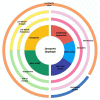Sarcopenic Dysphagia, Malnutrition, and Oral Frailty in Elderly: A Comprehensive Review
- PMID: 35267957
- PMCID: PMC8912303
- DOI: 10.3390/nu14050982
Sarcopenic Dysphagia, Malnutrition, and Oral Frailty in Elderly: A Comprehensive Review
Abstract
Frailty is a highly prevalent condition in the elderly that has been increasingly considered as a crucial public health issue, due to the strict correlation with a higher risk of fragility fractures, hospitalization, and mortality. Among the age-related diseases, sarcopenia and dysphagia are two common pathological conditions in frail older people and could coexist leading to dehydration and malnutrition in these subjects. "Sarcopenic dysphagia" is a complex condition characterized by deglutition impairment due to the loss of mass and strength of swallowing muscles and might be also related to poor oral health status. Moreover, the aging process is strictly related to poor oral health status due to direct impairment of the immune system and wound healing and physical and cognitive impairment might indirectly influence older people's ability to carry out adequate oral hygiene. Therefore, poor oral health might affect nutrient intake, leading to malnutrition and, consequently, to frailty. In this scenario, sarcopenia, dysphagia, and oral health are closely linked sharing common pathophysiological pathways, disabling sequelae, and frailty. Thus, the aim of the present comprehensive review is to describe the correlation among sarcopenic dysphagia, malnutrition, and oral frailty, characterizing their phenotypically overlapping features, to propose a comprehensive and effective management of elderly frail subjects.
Keywords: dysphagia; elderly; malnutrition; oral health; osteoporosis; sarcopenia; sarcopenic dysphagia.
Conflict of interest statement
The authors declare no conflict of interest.
Figures
References
-
- Abdullah B., Wolbring G. Analysis of newspaper coverage of active aging through the lens of the 2002 World Health Organization Active Ageing Report: A Policy Framework and the 2010 Toronto Charter for Physical Activity: A Global Call for Action. Int. J. Environ. Res. Public Health. 2013;10:6799–6819. doi: 10.3390/ijerph10126799. - DOI - PMC - PubMed
Publication types
MeSH terms
LinkOut - more resources
Full Text Sources
Medical



